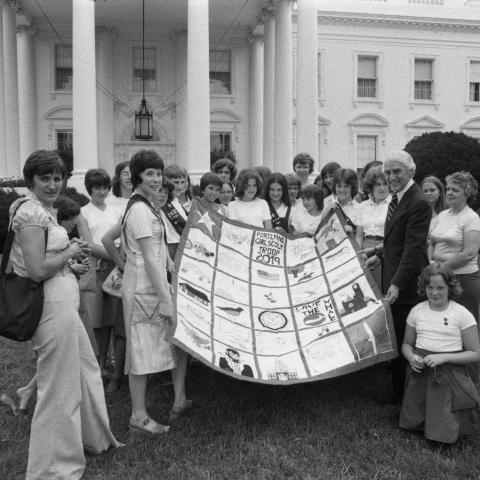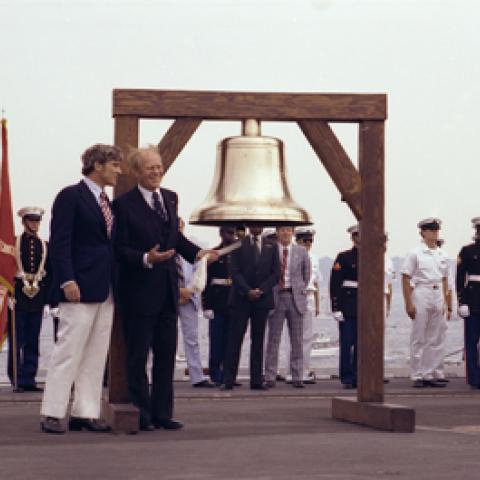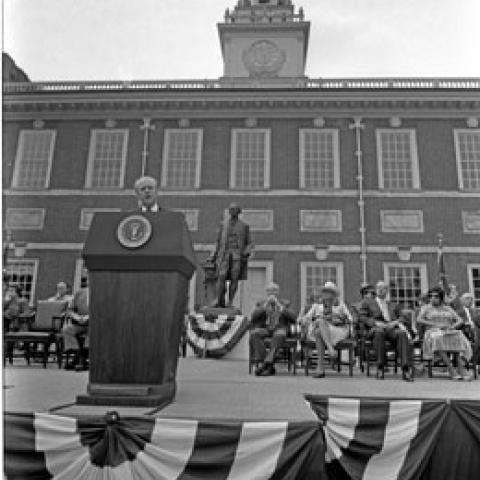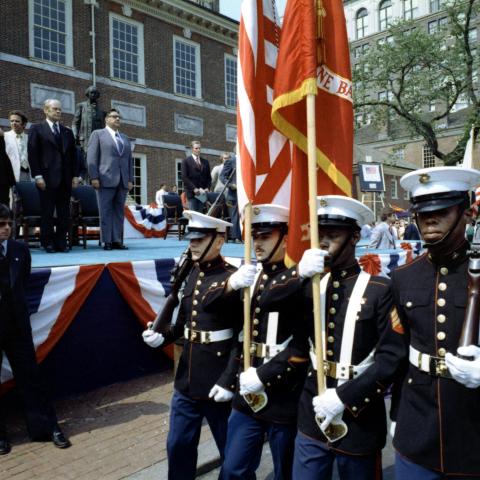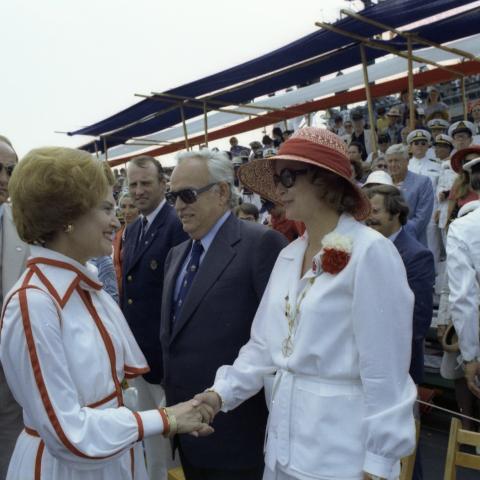
The United States Bicentennial was a series of events in celebration of the nation’s 200th birthday. The American Freedom Train, carrying artifacts, documents, and artwork for public view, began its 21-month tour of the 48 contiguous states on April 1, 1975. On April 18, 1975, President Gerald Ford visited the Old North Church in Boston, Massachusetts, where two lanterns were ceremoniously lit, along with a third lantern in recognition of the country’s third century. He then delivered a major address at Lexington and Concord commemorating the 200th anniversary of the battles that spurred the Revolutionary War.
The United States Congress had previously established the American Revolution Bicentennial Commission (ARBC) in 1966 to organize the Bicentennial celebration. The ARBC was criticized, however, for showing excessive political bias and commercialism. As a result, Congress replaced the ARBC with the American Revolution Bicentennial Administration (ARBA) in 1973. ARBA focused on supporting and coordinating state, local, and private celebrations, with around 66,000 recognized events in total. There were picnics, ceremonies, presentations, and numerous other festivities across the country. One of the most significant events was the Bicentennial Wagon Train Pilgrimage, in which volunteers from every state traveled eastward over historic trails in covered wagons. Bicentennial celebrations were not limited to the US. An exhibition titled The World of Franklin and Jefferson first opened in Paris, France, before travelling throughout Europe and the US.
The Bicentennial was also commemorated by two official state visits. In May 1976, President and Mrs. Giscard d’Estaing of France visited the United States in recognition of the history of friendship between the two countries. As a gift to the US, President d’Estaing presented a Sound and Light show at Mount Vernon. Two months later, in July 1976, Queen Elizabeth II and Prince Philip of Great Britain toured Philadelphia, the District of Columbia, Virginia, New York, Connecticut, and Massachusetts. On behalf of the British people, the Queen gifted to the United States the Bicentennial Bell, a replica of the Liberty Bell that hangs at Independence Hall in Philadelphia.
Official Bicentennial events culminated on July 4, 1976, the 200th anniversary of the signing of the Declaration of Independence. On this day, President Ford and his daughter Susan first travelled to Pennsylvania where President Ford spoke at Valley Forge to honor the conclusion of the Bicentennial Wagon Train Pilgrimage. They then proceeded to Independence Hall in Philadelphia, where President Ford signed the Bicentennial Day Declaration, which reaffirmed a commitment to the principles of liberty, justice, and freedom that were first laid out in the Declaration of Independence. Following that, the two flew to New York Harbor where First Lady Betty Ford also joined them to celebrate Operation Sail, an international naval review of ships sent by the navies of numerous countries. The day ended in DC, where President and Mrs. Ford watched fireworks from the White House Balcony.
The Bicentennial is noted for the feelings of patriotism and nostalgia that the celebrations inspired. There was a general feeling that the country was beginning to recover after the unstable period that included the Civil Rights Movement, the Vietnam War, and the Watergate crisis. In his autobiography A Time to Heal, President Ford described the effect that Bicentennial Celebrations had on the country: “Rarely in the history of the world had so many people turned out so spontaneously to express the love they felt for their country. Not a single incident marred our festival. The nation’s wounds had healed. We had regained our pride and rediscovered our faith, and in doing so, we had laid the foundation for a future that had to be filled with hope.”
To see more photos from the Bicentennial, check out the photo gallery of the Celebration of the Bicentennial of the American Revolution and the Bicentennial Artifacts. You can also explore the resource page for Entertaining Royalty: The State Dinner for Queen Elizabeth.
Digitized Resources
- Agriculture Department Bicentennial Leaflets
- American Issues Forum
- Bicentennial - General (1)
- Bicentennial - General (2)
- Bicentennial - General (3)
- Bicentennial - General (4)
- Bicentennial - General (5)
- Bicentennial Fellowships, Scholarships and Chairs at American Universities
- Bicentennial Medals
- Bicentennial Plaques
- Central Intelligence Agency Bicentennial Publication “Intelligence in the War of Independence”
- Cultural Laureate Foundation (1)
- Cultural Laureate Foundation (2)
- Federal Aid to Philadelphia and Washington (1)
- Federal Aid to Philadelphia and Washington (2)
- Interior Department
- Invitations for the President
- Marine Corps Bicentennial
- Mecklenburg Declaration of Independence
- National Endowment for the Arts Program Report
- Peoples Bicentennial Commission
- Rockefeller, John D.
- Security
- Town Meeting ‘76
- Transportation Department Bicentennial Program
- United States Information Agency - Report on Bicentennial Activities
- United States Information Agency - Research Report: Soviet Writings on the “First” American Revolution and the Bicentennial
- Virginia Bicentennial Programs
- “We, The People” - A Bicentennial Fair
In 1976, Congress introduced legislation that would have created the Bicentennial Land Heritage Program. The goal of the program was to improve and maintain National Park and National Wildlife Refuge lands.
- Federal Agency Bicentennial Task Force - Agency Reports
- Federal Agency Bicentennial Task Force - General
- Federal Agency Bicentennial Task Force - Letters of Appreciation to Members
- Federal Agency Bicentennial Task Force - Meeting Agendas (1)
- Federal Agency Bicentennial Task Force - Meeting Agendas (2)
- Federal Agency Bicentennial Task Force - Meeting Agendas (3)
- Federal Agency Bicentennial Task Force - Meeting Minutes and Summaries
- White House Bicentennial Task Force - General (1)
- White House Bicentennial Task Force - General (2)
- White House Bicentennial Task Force - General (3)
- White House Bicentennial Task Force - General (4)
- White House Bicentennial Task Force - Meeting, 6/24/1976 (1)
- White House Bicentennial Task Force - Meeting, 6/24/1976 (2)
- White House Bicentennial Task Force - Meetings (1)
- White House Bicentennial Task Force - Meetings (2)
- Certificate for Completion of the Bicentennial Wagon Train Pilgrimage to Pennsylvania Issued by the North American Trail Ride Conference
- Certificate of Appreciation From the Commonwealth of Pennsylvania Given For Participation in the Nation’s Bicentennial Wagon Train Pilgrimage to Pennsylvania
- Pamphlet for the Bicentennial Wagon Train Pilgrimage to Pennsylvania
- Official Souvenir Program of the Bicentennial Wagon Train Pilgrimage to Pennsylvania, 1975- 1976
- Blank Public Notice about Upcoming Encampment of the Bicentennial Wagon Train Pilgrimage to Pennsylvania
Horizons on Display was a jointly sponsored program of the Housing and Urban Development (HUD) and the American Revolution Bicentennial Administration (ARBA). “The goal of the program was to encourage information exchange among communities and to inspire local action on contemporary problems.”
